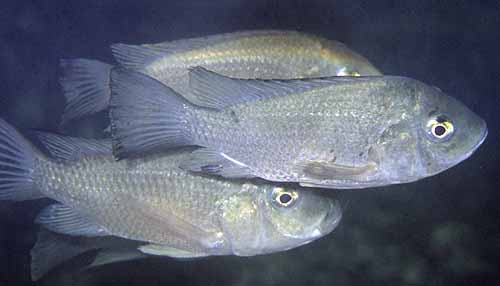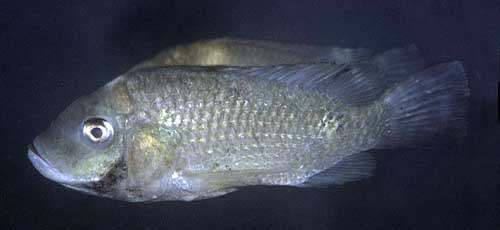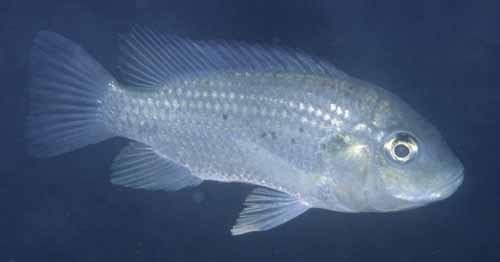|
Dear
Mr. Hoover,
I have just returned from a week's vacation
in O'ahu. While there I observed a fish that I could not identify.
It was not in your book "Hawaii's Fishes" or any other
sources that I have access to. I was wondering if you could help
me identify this mystery fish. The fish that I observed was first
seen from the shore at the breakwater at "Queen's Beach"
in Waikiki by Kapiolani Park. I also saw many of these fish another
day in the harbor by Magic Island. The actual fish itself was about
5-8 inches long and mottled green-brown to almost black in some
individuals. The fish had very large eyes (much like a Bigeye Emperor),
a blunt snout, and dark marking behind the gills. It was swimming
out in the open near the surface in a small school. After snorkeling
with them and trying to identify them, I asked a local what they
were called and he said they were locally called Talipo (spelling??),
but I have found no reference to them in any of the sources I have
looked at. So as I said, if you have enough time to help me identify
this mystery fish that would be great.
Sincerely,
James,
San Jose, California
Dear
James,
They sound like Tilapia - a freshwater
fish from Africa which was introduced to Hawaii and has a limited
ability to survive in salt water. They are common near shore in
Waikiki. I saw some there just the other day, in fact, and said
to myself that I should try to get a photo and put them into the
next edition of my fish book. I'm not sure at this point which species
of Tilapia they are. Thanks for the reminder to look into this!
Happy New Year,
John
|

Blackchin Tilapia
- Queen's Beach, Waikiki, O`ahu. 3 ft. |
|
TILAPIAS (family Cichlidae)
Tilapias are a group of hardy, fast-growing
fresh and brackish water fishes native to Africa and the Near East
which have been widely spread throughout the tropics for food and
aquaculture. Many are, or were at one time, classified in the genus
Tilapia, thus the common name. All tilapias are members of
the enormous freshwater fish family Cichlidae--the second-largest
fish family in the world and one of the most diverse. Some cichlids
are quite colorful. Because they are easy to breed, many have entered
the freshwater aquarium trade. Over the years, aquarists have released
a surprising number of cichlid species into Hawaii's streams and
reservoirs, where some have become established. Most of the tilapias,
however, were deliberately introduced beginning with four species
in the early 1950s brought in control vegetation in irrigation canals,
for possible use as baitfish, and also for human food and recreation.
Of these introduced species, the Mozambique Tilapia (Oreochromis
mossambicus) was at first the most successful, becoming almost
ubiquitous in the fresh and brackish waters of the Islands. Salt-tolerant,
it even entered the marine environment to some degree. However,
it has since been largely displaced by the even more hardy and adaptable
Blackchin Tilapia (Sarotherodon melanotheron), which was
introduced accidentally in 1965.
Sometimes called the "saltwater
tilapia", the Blackchin has the ability to survive, maybe even
to breed, in pure seawater and can be seen off sheltered beaches
and in lagoons around O`ahu and possibly the other islands. We do
not yet know yet what effect this fish will have on our marine ecosystems
but in places like Pearl Harbor or Kane`ohe Bay it is sometimes
caught in nets intended for the the Hawaiian Anchovy, or nehu,
a valuable baitfish, and may be preying upon them. (At other Pacific
Islands, such as Fanning and Nauru, the picture is more clear: introduction
of tilapias into saltwater ponds has damaged or destroyed traditional
culture of mullets and milkfish and eradication has proved impossible.)
In Hawai`i these fish are now considered pests in canals and reservoirs
because they reproduce quickly, out-compete other species, and then
often suffer massive die-offs. In 1991, for example, an estimated
20,000 tilapia--most of them Blackchins--died of a fungal infection
in Lake Wilson, O`ahu. These were estimated to represent half a
percent or less of the total tilapia population in the reservoir.
At present about 10 species of tilapias are believed to be established
in Hawai`i, although rampant hybridization can make identification
difficult and uncertain.
If you live on a Hawaiian island other
than O`ahu and have seen tilapia in pure seawater, please drop
me a line. For more information about Tilapia in Hawai`i see
"Hawaii's
Native & Exotic Freshwater Animals" by Mike N. Yamamoto
and Annette W. Tagawa.
|

Blackchin
Tilapia - Queen's Beach, Waikiki, O`ahu. 3 ft. |
BLACKCHIN
TILAPIA
Sarotherodon melanotheron Rüppell, 1852
These dull silvery or faintly yellowish fish are named for the black
coloration often present under the chin. When breeding, males may
become darker overall. These fish are mouthbrooders can sometimes
be seen holding eggs or fry in their mouths (as the fish above may
be doing). Originally from brackish estuaries and lagoons of west
Africa from Mauritania to Angola, they were introduced to Hawai`i
from New York in 1962 for possible use as a baitfish in the tuna fishery.
After proving unsuitable, they escaped their holding tanks and spread
quickly through the fresh and brackish waters of O`ahu. By the 1970s
they were abundant in Lake Wilson in Wahiawa and various other O`ahu
reservoirs, as well as in many lower streams and estuaries. Eventually
they displaced the Mozambique Tilapia (Oreochromis mossambicus)
as O`ahu's most common tilapia. Tolerant of high salinities that would
quickly kill other freshwater fishes, they have penetrated protected
coastal waters and now occur in such places as Pearl Harbor, Honolulu
Harbor, the Ala Wai Canal, and along Waikiki Beach. Off beaches and
open coasts they seem to be staying close to shore in waters less
than about 6 ft. deep and have not invaded the deeper reefs. Most
likely they cannot compete with true marine fish. Hopefully that will
not change in the near future. On O`ahu, a good place to see "saltwater
tilapia" is at the stone jetty between the Waikiki Aquarium and
the Kapahulu Groin (Kapahulu Ave.) at the Diamond Head end of Waikiki,
where you can easily spot them from shore swimming in small groups.
To about 10 in. Widespread throughout the tropics and subtropics in
fresh, brackish, and protected marine waters.
|
|
 Blackchin
Tilapia - Queen's Beach, Waikiki, O`ahu. 3 ft. Blackchin
Tilapia - Queen's Beach, Waikiki, O`ahu. 3 ft.
|
|


 Blackchin
Tilapia - Queen's Beach, Waikiki, O`ahu. 3 ft.
Blackchin
Tilapia - Queen's Beach, Waikiki, O`ahu. 3 ft.